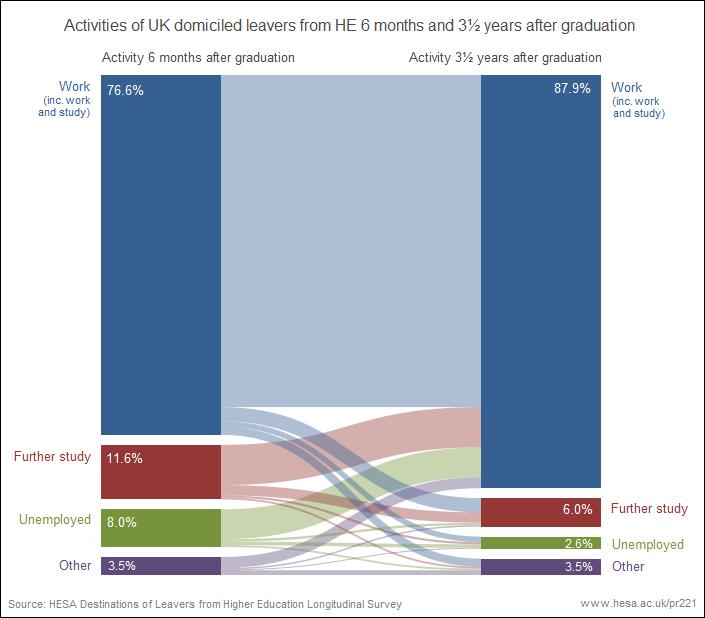Long-term graduate unemployment has returned to pre-recession levels, but more university leavers are working part-time or engaging in further study.
That is according to the Higher Education Statistics Agency’s longitudinal survey of university leavers, which found that only 2.6 per cent of the UK-domiciled class of 2011 were unemployed three and a half years later. That marks a return to the levels seen among the 2005 cohort at the same stage, and is a significant drop on the high of 3.5 per cent among 2007 leavers.
However, while the proportion of 2011 leavers in full-time work three and a half years on now stands at 73.4 per cent, up from 72 per cent in the previous study, it remains below the high of 76.1 per cent among 2005 graduates.
Some 8.2 per cent of the latest cohort to be surveyed are in part-time work, compared with 6.2 per cent among 2005 leavers, while the proportion in further study has grown from 5.5 per cent to 6 per cent over the same period.

The study, based on the responses of 81,650 people who had previously completed Hesa’s Destination of Leavers from Higher Education (DLHE) survey, found that 80.5 per cent of graduates said that they were now in “professional” occupations.
This contrasts with the claim made by a report published last week by the Chartered Institute of Personnel and Development, which stated that more than half of UK university leavers were working in non-graduate jobs.
The DLHE survey also finds that, while male graduates were more likely to be in full-time work three and a half years on than female graduates (77 per cent to 70.5 per cent), women were less likely to be unemployed than men (2.3 per cent to 3.3 per cent).
The gender pay gap seen on graduation persists, with the median salary for female first degree leavers in full-time employment standing at £24,000 (up from £18,500 six months after university), compared with £26,000 for men (up from £20,000).
Other findings detail the varying outcomes for graduates from different types of universities.
Graduates of the large, research-intensive institutions that make up the Russell Group were least likely to be unemployed, with only 1.7 per cent of their leavers falling into this category. However, they were also the least likely to be working only (79.5 per cent), and the most likely to be engaged in further study only (11.2 per cent).
Employment and unemployment rates among graduates of the former 1994 Group of smaller research-intensive universities were 81.1 per cent and 2.5 per cent respectively, compared with 84.7 per cent and 3.8 per cent among graduates of the post-1992 institutions that make up Million+.
For those who attended University Alliance institutions, employment and unemployment rates stood at 83.5 per cent and 2.5 per cent respectively, compared with 86.6 per cent and 2.1 per cent among those who studied at one of the specialist institutions in GuildHE.
The survey also found that 66.3 per cent of UK-domiciled 2011 graduates felt that their course was good value for money. However, university leavers who paid fees of up to £9,000 a year in England have yet to be asked the same question by Hesa.
Reacting to the survey results, Jo Johnson, universities and science minister, said: “These latest statistics are a further welcome sign that so many graduates enjoy high levels of employment, but there is more to do to ensure students get the teaching they deserve and employers get the skills they need.”




